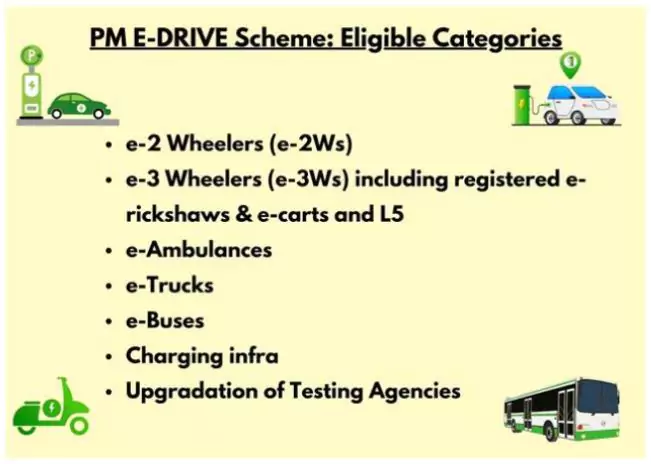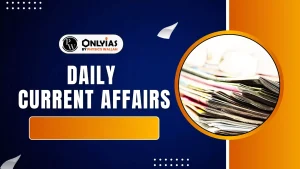The PM Electric Drive Revolution in Innovative Vehicle Enhancement (PM E-DRIVE) Scheme, launched in September 2024 has been extended from two to four years till 31 March 2028 for e-trucks, e-buses, and testing agencies, while timelines for smaller EV categories remain unchanged.
About PM Electric Drive Revolution in Innovative Vehicle Enhancement (PM E-DRIVE) Scheme

- The PM E-DRIVE Scheme, approved by the Union Cabinet on 29 September 2024, is a flagship programme of the Ministry of Heavy Industries (MHI) to accelerate electric mobility in India.
- Effective From: 1 October 2024
- Budgetary Allocation: Fund-limited outlay of ₹10,900 crore, valid till 31 March 2028 (originally till 31 March 2026).
- Implementing Agency: Ministry of Heavy Industries (MHI), with Convergence Energy Services Limited (CESL) as aggregator for electric bus procurement; coordination with Ministry of Road Transport and Highways (MoRTH), Ministry of Health and Family Welfare (MoHFW), and Ministry of Power (MoP) for various components.
- Objectives:
- Accelerate adoption of Electric Vehicles (EVs) across multiple segments.
- Establish a robust charging infrastructure in urban areas and along national highways.
- Strengthen the domestic Electric Vehicle (EV) manufacturing ecosystem through the Phased Manufacturing Programme (PMP) under Make in India and Aatmanirbhar Bharat.
- Promote mass mobility via electric public transportation, thereby improving air quality and reducing transport-related emissions.
- Eligibility: Applicable only to EVs with advanced batteries.
- Key Features & Targets:
| Demand Incentives |
- For Electric Two-Wheelers (e-2W) (~24.79 lakh units), Electric Three-Wheelers (e-3W) (~3.2 lakh units, including registered e-rickshaws and e-carts), Electric Ambulances (e-ambulances), Electric Trucks (e-trucks), and Electric Buses (e-buses).
- Incentive Rates: ₹5,000 per kilowatt-hour (kWh) for Financial Year (FY) 2024–25, ₹2,500 per kWh for FY 2025–26.
- Capped at 15% of ex-factory price or per-vehicle ceiling (whichever is lower).
- Government-purchased EVs ineligible; maximum one EV per category per beneficiary.
|
| Capital Asset Grants |
- ₹4,391 crore for 14,028 electric buses in 9 major cities (population above 40 lakh), with preference for cities scrapping old State Transport Undertaking (STU) buses under MoRTH guidelines.
- ₹500 crore for e-ambulances (standards set with MoHFW & MoRTH).
- ₹500 crore for e-trucks, with a scrapping certificate from MoRTH-approved Registered Vehicle Scrapping Facility (RVSF) mandatory.
|
| Charging Infrastructure |
- Outlay of ₹2,000 crore to install 22,100 fast chargers for e-4W, 1,800 fast chargers for e-buses, and 48,400 chargers for e-2W/e-3W.
- Testing Agency Upgradation:
- ₹780 crore to modernise and upgrade MHI testing facilities with emerging green mobility technologies.
|
Significance of PM E-DRIVE Scheme
- Boost to EV Adoption: Encourages faster transition from Internal Combustion Engine (ICE) vehicles to electric and hybrid vehicles, reducing dependency on fossil fuels.
- Reduction in Carbon Emissions: Supports India’s Net Zero by 2070 goal and NDC commitments under the Paris Agreement.
- Promotion of Domestic Manufacturing: Encourages Make in India by supporting local manufacturing of EVs, batteries, and related components, aligning with Atmanirbhar Bharat.
- Support for Innovation: Incentivises R&D in battery technologies, power electronics, and charging infrastructure.
- Job Creation: Opens opportunities in EV manufacturing, maintenance, battery recycling, and charging infrastructure sectors.
- Lower Operating Costs for Consumers: Subsidies and cost reduction measures make EVs more affordable in the long run.
- Energy Security: Reduces oil import bills by promoting renewable-powered mobility solutions.
- Urban Air Quality Improvement: Helps in tackling vehicular pollution, a major contributor to poor air quality in cities.
Comparative Table – Original vs. Revised PM E-DRIVE
| Parameter |
Original (2024 Notification) |
Revised (2025 Extension) |
| Launch Date |
29 Sept 2024 |
— |
| Outlay |
₹10,900 crore |
Same — ₹10,900 crore (fund-limited) |
| Duration |
2 years (till 28 Sept 2026) |
4 years (till 31 March 2028) |
| Coverage Segments |
e-2W, e-rickshaws/e-carts, e-3W (L5), e-trucks, e-buses, testing agencies |
Same segments |
| Terminal Date – e-2W, e-rickshaws/e-carts, e-3W (L5) |
31 March 2026 |
31 March 2026 (unchanged despite extension) |
| Reason for Duration |
Initial adoption push |
Additional time for e-trucks, e-buses, and testing agencies due to nascent market & procedural delays |
| Allocation for e-buses |
₹4,391 crore for 14,028 units |
Same; deployment starts March 2026 with milestone-linked disbursement over 18 months |
| Closure Clause |
Fund-limited |
Same — closes if funds exhausted before end date; no further claims after closure |
Read More About E-Mobility Push in India
![]() 9 Aug 2025
9 Aug 2025


